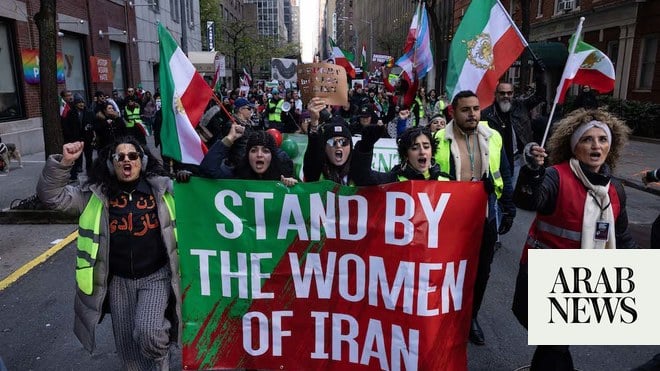
Consecutive waves of factional or popular protests across Iran, in addition to ongoing political and social mobilization, have been snowballing in recent months. This volatile situation is proving increasingly alarming for the Iranian leadership.
The seismic upheavals Iran is currently witnessing are uncannily reminiscent of those that preceded the 1979 revolution. The current protests also follow the trajectory of historical popular uprisings, the most recent of which were those that brought down several Arab regimes a decade ago. The striking aspect of the past and current protests is that any real change hinges on an unavoidable solution: Regime change.
From the Iranian people’s viewpoint, all of the country’s crises are because of the brutal theocratic elite that seized power in 1979 and has mismanaged the country for its own benefit and enrichment ever since, at the expense of society generally. This viewpoint is fueling Supreme Leader Ali Khamenei’s concerns about the future of the regime. The country is suffering from various complicated economic crises, not only due to America’s economic sanctions, but also because of the fallout from the coronavirus pandemic and the Russian invasion of Ukraine.
Iran’s growing political and social mobilization in light of its worsening economic crises led the regime to engineer the most recent parliamentary and presidential elections to ensure that the religious hard-liners and the Islamic Revolutionary Guard Corps monopolized all levers of power in the country. This engineering means that power is now concentrated in the hands of those who uncritically support the extremist, revolutionary Velayat-e Faqih regime amid its quest for survival.
Despite these attempts to shore up the regime, the Iranian leadership has actually exacerbated the country’s crises and undermined what legitimacy it still has left. It now faces a very genuine threat from the protesters, whose growing and sustained protest movement may spoil its plans to rule Iran perpetually.
In an attempt to prevent these protests from escalating and transforming from mere popular and factional protests with economic and political demands into a full-fledged uprising with the ultimate goal of overthrowing the regime, Khamenei this month used the anniversary of Ayatollah Khomeini’s death to send two important messages to the Iranian people. However, by sending these messages, Khamenei did not intend to provide any radical solutions to the country’s deep-rooted economic, political and social crises. Instead, he wanted to affect the course of the protests and downplay their impact on the Iranian regime’s future.
The supreme leader, as usual, cited far-fetched conspiracy theories and blamed the crises that Iran is suffering from on the regime’s enemies, accusing Western countries of spearheading the popular protests to deal a blow to the regime, as well as utilizing psychological warfare, the internet, mercenaries and dispensing money to achieve their goals.
The first part of the message conveyed a tacit but clearly understood threat to the Iranian public against staging further protests, with Khamenei hurling slander and accusations of treason to deter anyone from participating in the current or future protests. This message, of course, completely ignores the enormity of the suffering of the Iranian people, their grievances and the reasons why they take to the streets.
This message sharply contrasts with what Khamenei told the Middle East in 2011, when he delivered a speech in Arabic, urging the region’s peoples (presumably exempting Syrians) to revolt against their leaders and governments. This speech reinforced the belief held by the world about the Iranian regime’s hypocritical positions and its support for chaos in many regional countries and beyond, completely contradicting its leader’s and the constitution’s claims of wishing to help those who are vulnerable and oppressed.
Khamenei’s second message to the Iranian street was another thinly veiled warning of the dire consequences of responding positively to demands for regime change and turning the popular and factional demands into a full-fledged revolution, which demands the regime be brought down — as was the case with the 1979 revolution that toppled Shah Mohammed Reza Pahlavi.
Western countries, especially the US, have varied their positions on the protests in Iran, sometimes denouncing the regime’s crackdown on protesters and at other times declaring solidarity with their demands. However, Khamenei’s recent comments and accusations against the West, accusing it of conspiring to topple the regime, indicate his concern at the mounting level of popular discontent and the possibility that the situation may spiral out of control. This is especially true given Iran’s severe and worsening economic crisis, the stalled nuclear deal talks in Vienna and the fact that the short-lived optimism generated by what seemed like the imminent conclusion of an agreement with the major world powers is rapidly fading.The current Iranian regime’s vilification of the shah’s regime — which it accuses of being a Western stooge, repressing the Iranian people and causing economic crises — has been one of the key points of its propaganda over the past 43 years. Now, however, conditions in Iran are reaching levels that may well be worse than those experienced under the shah, placing the regime in Tehran in an awkward situation. The Iranian people are beginning to compare the past favorably to the present, with some yearning for the shah’s era. The rulers fear that these comparisons and repeated calls for regime change — encouraged by the shah’s son, Reza Pahlavi, who has weighed in and is leading an escalating protest movement in exile, calling on the West for help — may spark a new revolution.
It is unlikely that the Iranian people will pay any heed to the threats conveyed by the supreme leader, especially given the stalled Vienna talks and the regime’s failure to provide convincing and satisfying solutions to the country’s chronic crises. This means that Khamenei’s worst fears may well be realized.
Dr. Mohammed Al-Sulami is president of the International Institute for Iranian Studies (Rasanah). Twitter: @mohalsulami












